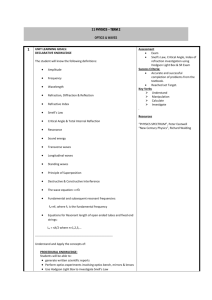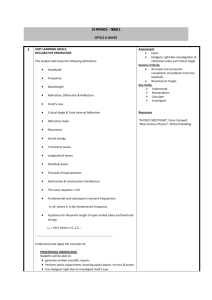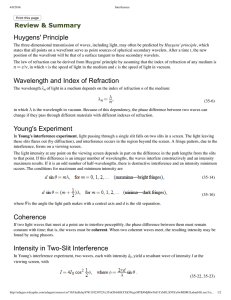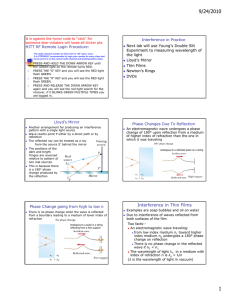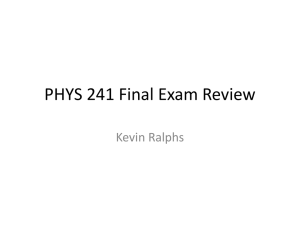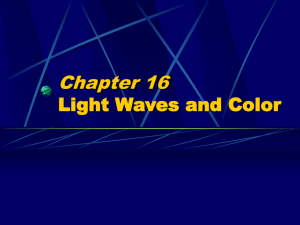2014 Refraction -Interactions of Light Directed
advertisement
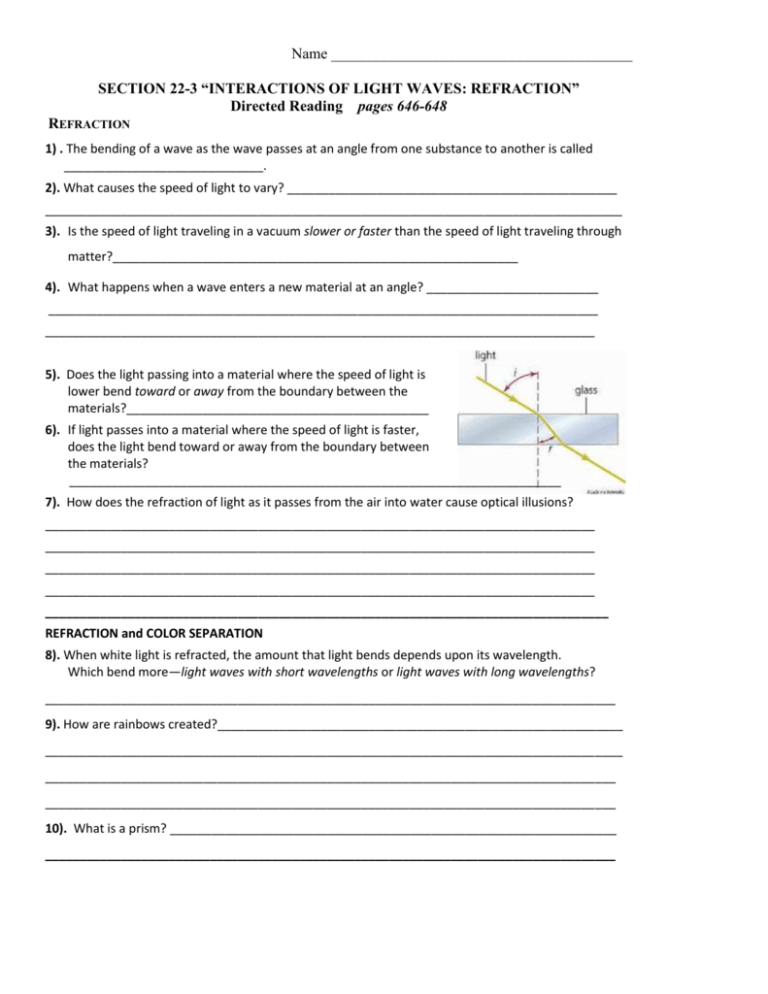
Name ________________________________________ SECTION 22-3 “INTERACTIONS OF LIGHT WAVES: REFRACTION” Directed Reading pages 646-648 REFRACTION 1) . The bending of a wave as the wave passes at an angle from one substance to another is called _____________________________. 2). What causes the speed of light to vary? ________________________________________________ ____________________________________________________________________________________ 3). Is the speed of light traveling in a vacuum slower or faster than the speed of light traveling through matter?___________________________________________________________ 4). What happens when a wave enters a new material at an angle? _________________________ ________________________________________________________________________________ ________________________________________________________________________________ 5). Does the light passing into a material where the speed of light is lower bend toward or away from the boundary between the materials?____________________________________________ 6). If light passes into a material where the speed of light is faster, does the light bend toward or away from the boundary between the materials? _______________________________________________________________________ 7). How does the refraction of light as it passes from the air into water cause optical illusions? ________________________________________________________________________________ ________________________________________________________________________________ ________________________________________________________________________________ ________________________________________________________________________________ __________________________________________________________________________________ REFRACTION and COLOR SEPARATION 8). When white light is refracted, the amount that light bends depends upon its wavelength. Which bend more—light waves with short wavelengths or light waves with long wavelengths? ___________________________________________________________________________________ 9). How are rainbows created?___________________________________________________________ ____________________________________________________________________________________ ___________________________________________________________________________________ ___________________________________________________________________________________ 10). What is a prism? _________________________________________________________________ ___________________________________________________________________________________ A. REFRACTION AND OPTICAL ILLUSIONS 1. Your brain always interprets light as traveling in a ___________________________________ from the object to your eye. 2. But, light reflecting from an object underneath the water _______________________ reflect in a straight line. 3. Refraction causes objects to appear _______________ and __________________than they really are. B. REFRACTION AND COLOR SEPARATION 1. White light is composed of all the__________________________________________. 2. The different wavelength are seen as ________________________________ 3. When white light is refracted, the amount that the light bends depends on its ____________________. a. Waves with a _________________ wavelength bend more than waves with a _________________ wavelength. b. A prism separates white light into the ________________ of visible light by refraction. c. Rainbows are formed when sunlight is refracted by ________________________________. IV. DIFFRACTION 1. Diffraction is the bending of waves______________________________________________________ 2. The amount a wave diffracts depends on its ____________________and the size of the ____________ _________________________________________________ a. Diffraction is greatest when the barrier or opening is the ______________ or __________________ than the wavelength. A. DIFFRACTION AND WAVELENGTH 1. Visible light’s wavelength is very small so it cannot diffract much unless it passes through a ________ _________________, around __________________________, or around a ______________________ 2. Light does not diffract ___________________ large objects, so you can’t see around corners. 3. But, light waves ___________________ diffract a. Diffraction causes the edges of _____________________ to be blurry. V. INTERFERENCE 1. Interference happens when two or more waves ____________________________ 2. Can be _______________________ or ________________________ A. CONSTRUCTIVE INTERFERENCE 1. The resulting wave has a greater _________________ or ____________ than the individual waves had. 2. Can be seen when light of one wavelength shines through two small holes onto a screen. The light on the screen will appear as a series of ______________________________________________________ 3. The brighter bands are the result of _____________________________ C. Destructive Interference 1. The resulting wave has a _________________________ amplitude than the individual waves. 2. The result is _____________________ light. It forms ______________ bands in the diagram above. 3. Since light is made up of many different wavelengths, the wavelengths ________________ line up for you to see constructive or destructive interference. SUMMARY _________________________________________________________________________ ___________ _________________________________________________________________________ _________________________________________________________________________ _________________________________________________________________________ _________________________________________________________________________ _________________________________________________________________________ _________________________________________________________________________ __________________________________________________________________ _________________________________________________________________________ _________________________________________________________________________ ______________________ .




